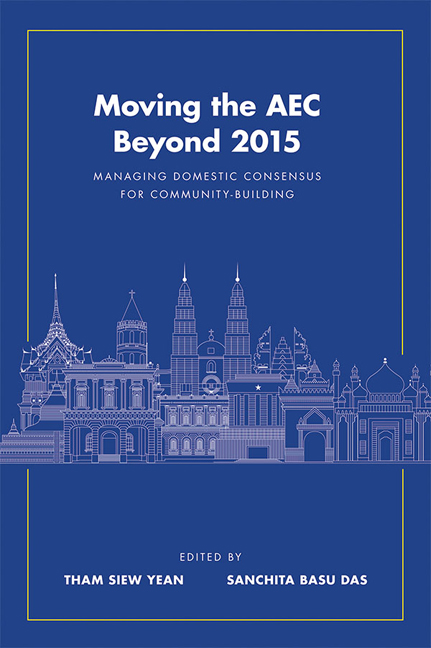Book contents
- Frontmatter
- Contents
- Foreword
- Preface
- Acknowledgements
- Abbreviations
- About the Contributors
- 1 Introduction: Economic Interests and the ASEAN Economic Community
- 2 ASEAN Economic Cooperation and Its Political Realities
- 3 Indonesia's Implementation of Facilitation and Harmonization Measures under the AEC
- 4 The AEC and Domestic Challenges in Malaysia: Examining the Liberalization of Services in AFAS
- 5 The Philippines and the AEC Beyond 2015: Managing Domestic Challenges
- 6 The AEC Beyond 2015: Implementation and Challenges for Singapore
- 7 Moving the AEC Beyond 2015: Managing Domestic Economic Interests in Thailand
- 8 Managing Domestic Consensus for ASEAN Community Building in Vietnam
- Index
2 - ASEAN Economic Cooperation and Its Political Realities
Published online by Cambridge University Press: 06 January 2018
- Frontmatter
- Contents
- Foreword
- Preface
- Acknowledgements
- Abbreviations
- About the Contributors
- 1 Introduction: Economic Interests and the ASEAN Economic Community
- 2 ASEAN Economic Cooperation and Its Political Realities
- 3 Indonesia's Implementation of Facilitation and Harmonization Measures under the AEC
- 4 The AEC and Domestic Challenges in Malaysia: Examining the Liberalization of Services in AFAS
- 5 The Philippines and the AEC Beyond 2015: Managing Domestic Challenges
- 6 The AEC Beyond 2015: Implementation and Challenges for Singapore
- 7 Moving the AEC Beyond 2015: Managing Domestic Economic Interests in Thailand
- 8 Managing Domestic Consensus for ASEAN Community Building in Vietnam
- Index
Summary
INTRODUCTION
The late Dr Goh Keng Swee, speaking in his capacity as then Minister for Finance of Singapore, made this insightful observation on regional economic cooperation in a speech delivered at the University of Singapore Society's annual dinner on 12 January 1970 (Goh 1995, pp. 104–11):
when people talk about regional economic cooperation, they talk as if this is something new. The truth is that, by any reasonable definition of the term, regional cooperation has been going on for more than a century, ever since the European imperialists set foot in this part of the world and opened it for economic development. What we are now doing is, in part, the outcome and the continuation of this long historical process (p. 105).
He then went on to outline the practical underpinnings for the then ASEAN members to trade with each other, citing the very real “value for money” from trade in goods and services among the different economies in the region. However, Dr Goh also acknowledged that the “classical doctrine of international trade” and the notion of free trade are rarely observed in their entirety in the real world, “either in Southeast Asia or elsewhere” (Goh 1995, p. 105). Close to five decades later, this observation still finds relevance in the efforts being made by members of the Association of Southeast Asian Nations (ASEAN) to achieve the ASEAN Economic Community (AEC) that will bring down barriers to free movement of goods, services, capital, and skilled labour across sovereign borders in the region. With 91 per cent of the 506 AEC measures being accomplished,1 member states are now faced with the challenge of addressing behind-the-border barriers, and negotiating a comprehensive regional trade arrangement with several of ASEAN's external partners (Goh 1995, p. 104).
Despite the hype and excitement over what will be ushered in by end-2015 as the first milestone of the AEC, which is part of a politically, economically and socially integrated ASEAN Community, there is a sense of déjà vu. The reality is that the deliberate and planned intergovernmental measures taken by sovereign governments to benefit from international trade, requires the will and capacity of all parties negotiating these agreements to commit to and implement these complex plans and arrangements. Thus, national-level follow-through is important to give effect to regional commitments.
- Type
- Chapter
- Information
- Moving the AEC Beyond 2015Managing Domestic Consensus for Community-Building, pp. 24 - 43Publisher: ISEAS–Yusof Ishak InstitutePrint publication year: 2016

